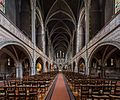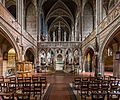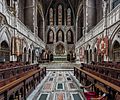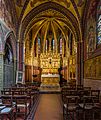St Augustine's, Kilburn facts for kids
Quick facts for kids St Augustine's, Kilburn |
|
|---|---|
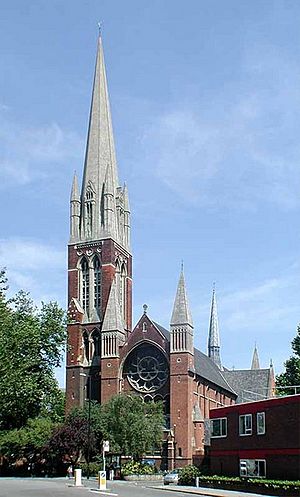 |
|
| Location | City of Westminster, London |
| Country | England |
| Denomination | Church of England |
| Churchmanship | Anglo-Catholic |
| History | |
| Founder(s) | Richard Carr Kirkpatrick |
| Dedicated | 1880 |
| Architecture | |
| Architect(s) | John Loughborough Pearson |
| Years built | 1871–1897 |
| Administration | |
| Diocese | London |
Saint Augustine's, Kilburn, is a beautiful Church of England church. It is located in the Kilburn area of North London, England. Because it is so large and has amazing designs, people sometimes call it "the Cathedral of North London." But it's important to know that it's not an official cathedral.
Contents
The Church's Story
St Augustine's Church was started in 1870 by a person named Richard Carr Kirkpatrick. He wanted it to follow the Anglo-Catholic tradition, which is a special way of worship within the Church of England.
In 1871, they laid the first stone for the new building. The first church was a simple "iron church." Soon, it was replaced by a much grander building. This new church was designed by a famous architect named John Loughborough Pearson. He used a style called Gothic Revival, which looks like old medieval churches. This church is so important that Historic England has listed it as a Grade I building. This means it's a very special historic place.
Amazing Design and Art
Pearson's plans for the church included red brick walls and arched ceilings. He also planned for many stone carvings inside. The style reminds people of churches from the 1200s. The church was officially opened in 1880. However, the tall tower and spire were not finished until 1897–1898. These parts were very impressive for their time.
Sir Giles Gilbert Scott designed the reredos (altar screens) for the main altar in 1930. He also designed the screens for the Lady chapel and the Stations of the Cross. Even before the church was finished, a historian named Edward Walford called St Augustine's "one of the finest examples of church buildings in London."
The church's spire is very tall, measuring over 77 metres (253 feet) high. The main part of the church, called the nave, was finished in 1878. It is nine metres (30 ft) wide and has nine sections. There are also two side sections called transepts.
The church is filled with beautiful religious art. This art shows many important stories from the Bible. Clayton and Bell made the amazing stained glass windows. One large round window, called a rose window, shows the story of Creation. There are also nine windows high up, called clerestory windows, with five of them showing different types of angels. Other windows show saints connected to England. One window shows Saint Augustine himself.
Paintings around the nave show stories of Jesus healing people. The front parts of the church, called the chancel and sanctuary, have many detailed carvings. These carvings show the Passion, Crucifixion, Entombment, and Resurrection of Christ. They also show the Apostles, saints, and other religious symbols.
The south transept leads to St Michael's Chapel. This chapel has pictures of the Eucharist, sacrifice, angels, and the worship of Heaven. The Lady Chapel has paintings of the Christ child. It also has a later carving of Christ's Presentation in the Temple.
St Augustine's Today
The church stands out in its location, south of Kilburn and north of Maida Vale. St Augustine's is also connected to two schools: St Augustine's Primary School and St Augustine's High School.
Who Led the Church?
Richard Carr Kirkpatrick was the first main priest at Saint Augustine's, Kilburn. He served from 1870 to 1907. He started this church after his previous church, St Mary's, got a new leader who didn't agree with his views. Kirkpatrick also helped Emily Ayckbowm start the Community of the Sisters of the Church here in 1870.
After Kirkpatrick, these people served as the main priest (vicar):
- Philip Leary, 1907–1930
- William Percy Theodore Atkinson, 1930–1954
- Harold Riley, 1955–1975
- Claude Eric Hampson, 1975–1977
- Raymond John Avent, 1977–1987
- Paul Tudor Rivers, 1987–1994
- Anthony H. Yates, 1995–2011
- Colin J. Amos, 2012–present
Images for kids
See also
 In Spanish: Iglesia de San Agustín (Kilburn) para niños
In Spanish: Iglesia de San Agustín (Kilburn) para niños


